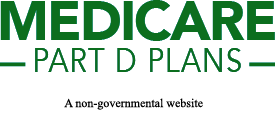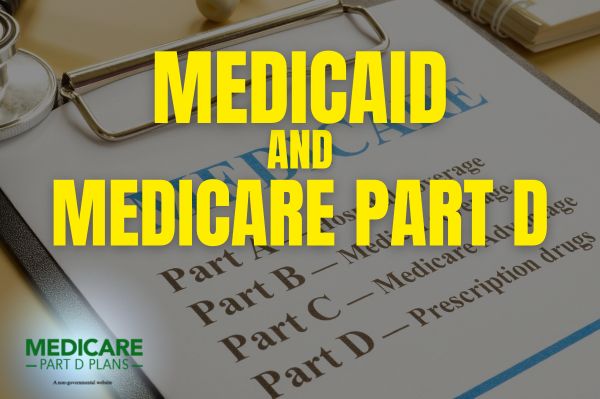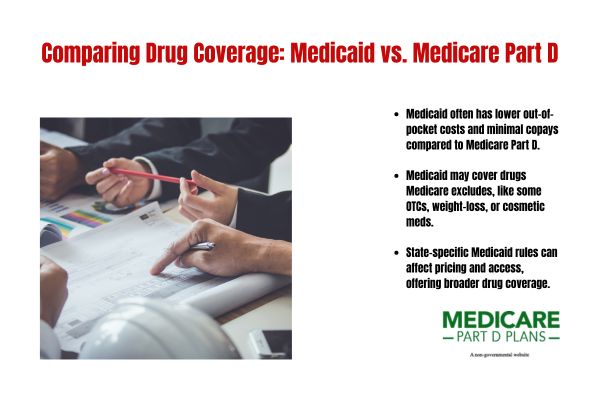Find a Medicare Part D prescription drug plan

Medicare Part D
Prescription Drug Coverage 2026
If I Have Medicaid, Do I Need Medicare Part D?
If you’re on Medicaid, you may be questioning whether you also need Medicare Part D for prescription drug coverage. This article breaks down the main difference between Medicaid and Medicare Part D, comparing their coverage options, possible costs, and benefits, to help you make an informed decision.
Key Takeaways
- Medicaid may provide broader drug coverage and lower out-of-pocket costs compared to Medicare Part D, likely making it a critical resource for low-income beneficiaries.
- Dual-eligible individuals could potentially benefit from both Medicaid and Medicare Part D, combining the programs to help enhance access to a wider range of medications and possibly reduce overall healthcare costs.
- Enrolling in Medicare Part D is straightforward for Medicaid recipients, with automatic enrollment options and designated enrollment periods available for those needing to adjust their plans.
Overview of Medicaid and Medicare Part D
Medicaid may act as a lifeline for millions of Americans, likely offering comprehensive health coverage to those with limited income and resources. As a joint federal government and state program, Medicaid will likely be designed to ensure that vulnerable populations could have access to essential medical services.
This might include funding medical assistance for lower-income individuals and families, possibly providing a crucial safety net in times of need.
On the other hand, Medicare Part D focuses specifically on prescription drug coverage for eligible individuals. Unlike Medicaid, which may have a broader scope of medical services, Medicare Part D will likely be tailored to help beneficiaries manage their medication needs.
This program may allow enrollees to pay a small copayment for each prescription, possibly making essential drugs more accessible.
There may be some notable differences in how Medicaid and Medicare Part D might handle drug coverage:
- Medicaid may cover certain medications that may be legally excluded from Medicare’s coverage, such as those for cosmetic uses or cold symptom relief.
- Medicaid’s drug formulary might include a wider range of medications compared to Medicare Part D, possibly giving Medicaid beneficiaries with more options.
Additionally, Medicaid may employ fewer restrictions on drug access than Medicare Part D, which might make it easier for beneficiaries with disabilities to obtain necessary medications. This more flexible approach could significantly impact on the quality of life for those relying on these programs for their healthcare needs.
How Medicaid Covers Prescription Drugs
Medicaid’s approach to prescription drug coverage will likely be shaped by the needs of the populations it serves. Various states will likely offer coverage for outpatient prescription medications to those who meet categorical eligibility under Medicaid, possibly providing essential access to necessary treatments.
Although not mandated by federal law, some states may have opted to include outpatient prescription drug coverage in their Medicaid programs.
Medicaid may also go beyond prescription medications and might cover some over-the-counter drugs. This may include medications for common ailments like cold and flu, which might not be included under Medicare Part D. This broader coverage could potentially ensure that beneficiaries have access to a wide range of treatments without incurring high out-of-pocket costs.
Additionally, Medicaid may also provide coverage for select prescription vitamins and certain non-prescription drugs, possibly offering a more comprehensive approach to healthcare. This could be particularly beneficial for dual-eligible individuals, who may rely on these additional options to manage their health effectively.
What Medicare Part D Offers
Medicare Part D will likely provide a structured and focused approach to prescription drug coverage, which might help beneficiaries manage their medication needs efficiently. Enrollees in Medicare Part D may pay a small copayment for each prescription, likely ensuring that essential medications are affordable.
During the initial coverage phase, enrollees may be responsible for up to 25% coinsurance for covered Part D drugs, likely making it crucial to budget for these costs.
However, once the enrollee reaches the annual out-of-pocket (OOP) spending threshold of about $2,100 in CY
The annual deductibles amount for CY
Additionally, the Inflation Reduction Act of 2022 might introduce several changes to the Part D benefit, such as a selected drug subsidy program where Part D sponsors may receive a government subsidy for selected drugs equal up to 10% of the drug’s negotiated price.
These structured phases and subsidies will likely aim to make prescription drugs more affordable and accessible, possibly provided a safety net for those with high medication costs.
Dual Eligibility: Having Both Medicaid and Medicare
For those qualifying for both Medicare and Medicaid (dual-eligible), the coordination of benefits could greatly enhance original Medicare coverage. Medicare will likely be the primary payer, while Medicaid could act as a supplemental payer, covering costs that Medicare does not, such as certain non-prescription drugs and medical supplies.
One of the potential advantages of being dual-eligible might be the automatic qualification for Extra Help with drug costs. This assistance could potentially reduce out-of-pocket expenses, possibly making medications more affordable.
Dual eligibility could also mean that prescription drugs covered by Medicare Part D may still receive additional coverage from Medicaid, especially for medications not included in Medicare’s formulary.
Moreover, special Medicare Advantage plans may also be available for dually eligible individuals, which could potentially simplify access to necessary services.
These plans, often referred to as Dual Eligible Special Needs Plans (d snp plans), will likely be designed to integrate the benefits of both Medicare and Medicaid, possibly providing a seamless healthcare experience. Additionally, a Medicare advantage plan may further enhance the options available to eligible individuals.
However, navigating dual eligibility might be complex, so it’s important to seek guidance from resources like the National Council on Ages (NCOA) or local State Health Insurance Assistance Programs (SHIP) to understand the full scope of benefits for older individuals and how to access them effectively.
Comparing Drug Coverage: Medicaid vs. Medicare Part D
Several differences may exist when comparing drug coverage under Medicaid and Medicare Part D:
- Medicaid might require lower out-of-pocket expenses for beneficiaries.
- Medicaid may involve minimal copayments for covered drugs.
- This could make a significant difference for individuals with limited income.
Medicaid’s drug formulary may be more inclusive than Medicare Part D, likely covering certain medications that Medicare does not, such as drugs for cosmetic purposes or weight management. This broader coverage could be crucial for beneficiaries needing access to a wider range of treatments.
Medicaid may also provide coverage for drugs excluded from Medicare Part D, which might help to lower out-of-pocket costs for beneficiaries.
This may include some over-the-counter medications and specific drug classes that Medicare may not cover. Some states may also have the authority to set their own pharmacy pricing standards within Medicaid, which could further influence drug costs and access.
Understanding these differences could help beneficiaries choose the most suitable medical insurance coverage for their needs, likely balancing cost and access to essential medications.
When You Might Need Medicare Part D with Medicaid
There may be specific scenarios where having both Medicaid and Medicare Part D could be particularly beneficial. For instance, while Medicaid might require small copayments for prescriptions, Medicare Part D could provide access to a broader range of prescription drugs, which might not be covered under Medicaid. This expanded access could potentially be crucial for individuals with high prescription needs.
Patients facing high prescription costs might find Medicare Part D advantageous for helping to reduce overall healthcare expenses. The structured cost-sharing phases of Medicare Part D, including the catastrophic phase, may offer significant financial relief.
Combining Medicaid with Medicare Part D could potentially enhance drug coverage, possibly ensuring access to a comprehensive range of medications while effectively managing out-of-pocket expenses.
How to Enroll in Medicare Part D If You Have Medicaid
Enrolling in Medicare Part D if you have Medicaid is a straightforward process, primarily because individuals with Medicaid may be automatically enrolled in a Medicare Part D plan. This automatic enrollment may help to ensure that beneficiaries do not experience any gaps in their prescription drug coverage.
The Open Enrollment Period for Medicare Part D runs from October 15 to December 7 each year, providing an opportunity to review and change plans if necessary. Additionally, certain individuals may qualify for a Special Enrollment Period, allowing them to enroll outside of the standard timeframe due to specific circumstances.
To enroll, you can use this website or call one of our licensed agents at 1-866-930-4039 (TTY 711) Mon-Fri: 8am-8pm EST.
See plans in your area instantly!
Advertisement
Possible Cost Considerations for Dual Eligible Individuals
For dual eligible individuals, understanding the potential cost of Medicare Part D is essential.
The deductible for Medicare Part D plans
However, once enrollees reach the catastrophic phase, they may not incur out-of-pocket costs for covered Part D drugs, possibly providing further financial relief.
Additionally, the Medicare Savings Programs could provide financial assistance with Medicare premiums and cost-sharing for people with low incomes and limited financial resources. These programs might help mitigate the costs associated with Medicare Part D, likely making healthcare more affordable.
Protecting Yourself from Medicare Fraud
Protecting yourself from Medicare fraud will likely be a crucial aspect of managing your healthcare coverage. Never share your Medicare number with anyone except authorized healthcare providers and guard your card as you would any personal financial document.
Be cautious of unsolicited offers for Medicare plans or services, as these are often fraudulent. To protect yourself:
- Avoid engaging with door-to-door salespeople offering medical products or services, as this can be a common scam.
- Regularly review your Medicare statements to ensure all billed services were received.
- Use this review to help detect and report any fraudulent activity.
Staying vigilant and informed could help protect against fraud and learn about appropriate use of your updated Medicare benefits, so you don’t lose them.
Find a Plan and Enroll Online Yourself!
Advertisement
Summary
Understanding the interplay between Medicaid and Medicare Part D will likely be crucial for making informed healthcare decisions. Medicaid could provide broad health coverage for low-income individuals, such as a wide range of prescription and non-prescription medications, while Medicare Part D will likely focus on prescription drug coverage with structured cost-sharing phases. This complimentary approach may optimize drug coverage and possibly minimize out-of-pocket expenses for beneficiaries.
For dual-eligible individuals, the potential benefits of combining Medicaid and Medicare Part D may be significant. Medicaid’s broader drug formulary and fewer restrictions on drug access, coupled with Medicare Part D’s structured cost-sharing and catastrophic coverage, could provide a comprehensive safety net. Special Medicare Advantage plans will likely be designed for dual-eligible individuals to help further secure seamless access to necessary healthcare services.
Ultimately, whether you need Medicare Part D in addition to Medicaid likely depends on your specific healthcare needs and financial situation. By leveraging the resources available and seeking guidance from experts, you can navigate these programs effectively and secure the best possible coverage for your needs.
Frequently Asked Questions
What is the difference between Medicaid and Medicare Part D?
The main difference is that Medicaid could provide comprehensive health coverage for low-income individuals, while Medicare Part D may specifically offer prescription drug coverage for eligible Medicare beneficiaries.
Can Medicaid cover drugs that Medicare Part D does not?
Yes, Medicaid might cover drugs that Medicare Part D does not, which may include some medications for cosmetic purposes and certain treatments not covered by Medicare.
What are the cost-sharing phases for Medicare Part D in 2026 ?
The initial coverage phase of Medicare Part D may involve a coinsurance of about 25%, and once the annual threshold has been met, beneficiaries may face no out-of-pocket costs in the catastrophic phase.
How can I protect myself from Medicare fraud?
To effectively protect yourself from Medicare fraud, guard your Medicare card, avoid sharing personal information, and review your Medicare statements regularly for accuracy. Staying vigilant against unsolicited offers is also crucial.
Where can I find more information about Medicaid and Medicare?
For comprehensive information on Medicaid and Medicare, enter your zip code into this website or call one of our licensed agents at 1-866-930-4039 (TTY 711) Mon-Fri: 8am-8pm EST.
Begin Choosing your plan
Advertisement
ZRN Health & Financial Services, LLC, a Texas limited liability company.



